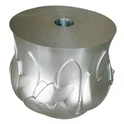Hey there! As a supplier in the aluminium fabrication business, I often get asked about the heat treatment process for aluminium. It's a crucial part of what we do here, so I thought I'd take a moment to break it down for you.
First off, why do we heat treat aluminium? Well, aluminium is a pretty versatile metal, but it can be a bit soft in its natural state. Heat treatment helps us enhance its mechanical properties, like hardness, strength, and durability. This makes it suitable for a wide range of applications, from Customized Training Bike Frame Fabrication Aluminium with Powder Coating to Customized CNC Processing Aluminum Fabrication for Truck Tool Cabinet and Custom Aluminium Box OEM Aluminum Fabricated Products.
There are mainly three types of heat treatment processes for aluminium: annealing, solution heat treatment, and precipitation hardening. Let's start with annealing.
Annealing is like giving the aluminium a big chill pill. We heat the aluminium to a specific temperature and then cool it down slowly. This process relieves internal stresses that might have built up during fabrication, like rolling or machining. It also makes the aluminium more ductile, which means it can be bent and shaped more easily without cracking.
The temperature for annealing depends on the type of aluminium alloy. For most common alloys, we heat it up to around 300 - 450 degrees Celsius. Once it reaches the right temperature, we hold it there for a certain period, usually a few hours. Then, we let it cool down gradually. This slow cooling is important because it allows the atoms in the aluminium to rearrange themselves in a more stable structure.
Next up is solution heat treatment. This one's a bit more intense. We heat the aluminium to a much higher temperature, usually between 450 - 550 degrees Celsius. At this temperature, the alloying elements in the aluminium dissolve into the aluminium matrix, forming a single-phase solid solution.
After that, we quickly quench the aluminium in water or another cooling medium. This rapid cooling "freezes" the dissolved alloying elements in place, creating a supersaturated solid solution. The aluminium becomes softer and more ductile right after solution heat treatment, but it's not very strong yet. That's where precipitation hardening comes in.
Precipitation hardening, also known as age hardening, is the process that really makes the aluminium tough. After solution heat treatment, we heat the aluminium to a lower temperature, around 100 - 200 degrees Celsius, and hold it there for a specific time. This causes the dissolved alloying elements to form tiny particles, or precipitates, within the aluminium matrix.


These precipitates act like little roadblocks for the movement of dislocations in the aluminium. Dislocations are like defects in the crystal structure of the metal, and when they move, they allow the metal to deform. By blocking the movement of dislocations, the precipitates make the aluminium harder and stronger.
The time and temperature for precipitation hardening depend on the specific alloy and the desired properties. Some alloys can reach their maximum hardness in just a few hours, while others might take several days.
Now, let's talk about the equipment we use for these heat treatment processes. We have specialized furnaces that can accurately control the temperature and the heating and cooling rates. These furnaces are designed to heat the aluminium evenly, ensuring that every part of the workpiece gets the same treatment.
We also have a quality control system in place to make sure that the heat treatment process is done correctly. We use thermocouples to monitor the temperature inside the furnace and check the hardness and other properties of the heat-treated aluminium using various testing methods.
One of the challenges we face in heat treating aluminium is distortion. When the aluminium is heated and cooled, it expands and contracts. If this expansion and contraction are not uniform, it can cause the workpiece to warp or bend. To minimize distortion, we use fixtures to hold the aluminium in place during heat treatment and carefully control the heating and cooling rates.
Another challenge is oxidation. Aluminium can easily oxidize when heated in air, forming a layer of aluminium oxide on the surface. This oxide layer can affect the appearance and properties of the aluminium. To prevent oxidation, we sometimes use protective atmospheres in the furnace, like nitrogen or argon.
So, there you have it - a brief overview of the heat treatment processes for aluminium in fabrication. These processes are essential for making high-quality aluminium products that can meet the diverse needs of our customers.
Whether you're looking for Customized Training Bike Frame Fabrication Aluminium with Powder Coating, Customized CNC Processing Aluminum Fabrication for Truck Tool Cabinet, or Custom Aluminium Box OEM Aluminum Fabricated Products, we've got the expertise and the technology to deliver.
If you're interested in our aluminium fabrication services or have any questions about the heat treatment process, don't hesitate to reach out. We're always happy to have a chat and see how we can help you with your project.
References
- ASM Handbook, Volume 4: Heat Treating, ASM International
- Aluminum Association, Technical Publications on Aluminum Heat Treatment






